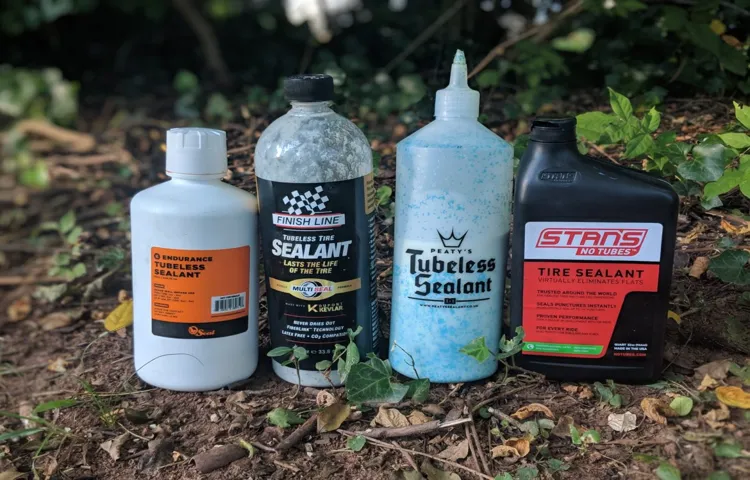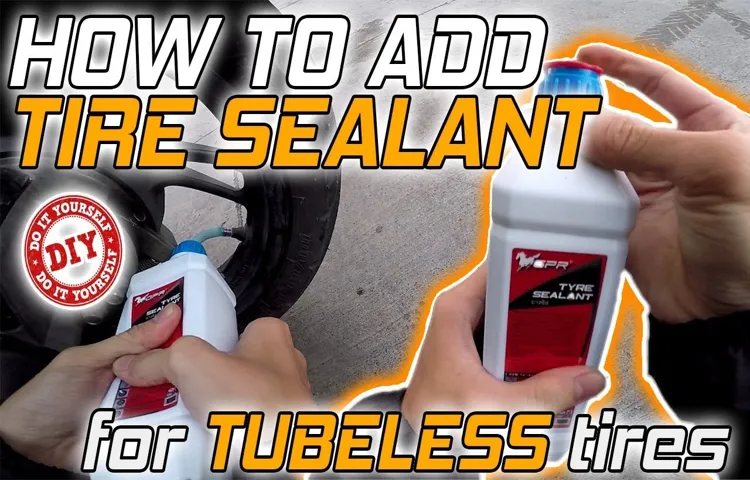Tubeless tires have been gaining popularity among cycling enthusiasts for their improved performance and reduced risk of punctures. However, maintaining them can be a challenge, especially when it comes to cleaning the sealant. Over time, tubeless tire sealant can dry up and become thorny, affecting the tire’s performance.
But how do you clean it off without damaging the tire? In this blog, we’ll take you through the steps on how to clean tubeless tire sealant effectively, ensuring your tires perform optimally and last longer. From removing the tire to cleaning the sealant, we’ll cover everything you need to know to get the job done like a pro!
Table of Contents
What is Tubeless Tire Sealant?
Tubeless tire sealant is a vital component of any tubeless setup. It is a liquid that is placed inside the tire that helps seal any punctures or cuts to the tire’s casing to prevent air from escaping. Although this sealant is a great innovation that can help you avoid flat tires on the road, it can also be messy and leave residue when it comes to cleaning.
To effectively clean tubeless tire sealant, it is best to use a rag and a cleaning solution that is mild and not as abrasive. You also want to make sure that you remove the valve core and any remaining sealant from the tires before you start cleaning. Once done, it is important to dispose of the sealant properly, as it can be harmful to the environment if not taken care of correctly.
Knowing how to clean tubeless tire sealant properly will ensure that your tubeless tires stay in good condition for longer, giving you a smoother ride.
How Does Tubeless Tire Sealant Work?
Tubeless tire sealant is a liquid solution used primarily in tubeless tire systems as a puncture preventive measure. Tubeless tire systems are used primarily in bicycles, but they are increasingly being used in cars too. This sealant is typically added to the tire through the valve stem, and it flows throughout the tire for even coverage.
When a puncture occurs, the sealant rushes to the site of the hole and quickly seals it. The sealant is made of a latex or synthetic substance, including microfibers that work cohesively to clog up the hole. The sealant forms a permanent seal when it dries, making the tubeless system as good as new.
The solution is regularly recommended by bike and car enthusiasts and can last for 2-6 months, depending on the frequency of use and the tire’s puncture tendencies. Tubeless tire sealant is a small investment with great benefits in preventing punctures, saving riders money, and decreasing downtime in case of a flat tire. So, it’s a wise choice to consider its use for both casual and competitive riders.

Why Clean Tubeless Tire Sealant?
Cleaning tubeless tire sealant can be a daunting task, but it is essential for maintaining the longevity and performance of your bike’s tires. Over time, sealant can build up and form clumps inside the tire, which can result in uneven weight distribution and potential tire punctures. To clean tubeless tire sealant, you first need to remove the tire from the rim and pour out any excess sealant.
Next, use a simple cleaning solution of warm water and dish soap to scrub the inside of the tire with a brush. Be sure to rinse the tire thoroughly and allow it to air dry before adding fresh sealant and reattaching it to the rim. Cleaning your tubeless tire sealant regularly will not only keep your bike running smoothly but also prolong the life of your tires.
Reasons to Clean Tubeless Tire Sealant
Tubeless tire sealant is a must-have for any cyclist who wishes to avoid punctures on their wheels. However, it is crucial to clean this sealant regularly to ensure the better performance of your tires. In addition, cleaning is necessary when you need to replace the sealant, especially if it has been in use for a while.
Using old, dirty tire sealant can cause blockages in the valve or nozzle or lead to a malfunction of the tubeless system. Furthermore, the dirty sealant can mix with new sealant during the refill process, which can cause the new sealant to clump up, defeating the purpose of using it. Another reason to clean the sealant is that its formula may have degraded, causing it to lose its efficacy in plugging holes.
Therefore, cleaning the sealant regularly prevents any clogs from happening and ensures that the sealant in your tubeless tires functions as it should. Ultimately, cleaning tubeless tire sealant adds to the overall longevity of your cycling equipment.
When to Clean Tubeless Tire Sealant?
Tubeless tire sealant is a key component of any tubeless bike setup, as it helps to prevent flat tires. However, it’s important to clean and replace the sealant periodically to ensure optimal performance. But how do you know when it’s time to clean the sealant? Well, one key indicator is if you notice a significant decrease in tire pressure, which could mean that the sealant has dried or become ineffective.
Additionally, if you notice clumps or chunks in the sealant, it’s likely time to clean it out and replace it with fresh sealant. Overall, cleaning and replacing tubeless tire sealant is an important part of maintaining a reliable bike setup, and it’s worth taking the time to ensure you’re doing it properly.
How to Clean Tubeless Tire Sealant?
If you own a tubeless tire system, you know the importance of having sealant in your tires to prevent punctures and maintain air pressure. However, the downside is that eventually, you will need to clean the sealant from your tires. Cleaning your tires is essential as leaving sealant in for too long can lead to clumps, blockages, and even mold growth.
To clean the sealant, first, remove the tire from the rim and pour out any remaining sealant. Scrub the inside of the tire with warm soapy water or a sealant-specific cleaner. Rinse thoroughly and let air dry.
For the rim, scrape off any dried sealant with a plastic item and clean with a cloth and a sealant-specific cleaner. Remember, it’s essential to keep your tires clean to maintain their longevity and efficiency in preventing punctures.
Materials needed for Cleaning Tubeless Tire Sealant
If you’re a cyclist who’s ever had the misfortune of fixing a flat tire, you’re probably familiar with tubeless tire sealant. While it’s a lifesaver on the road, it can be a bit of a nuisance when it comes time to clean your tires. To get started, you’ll need a few items: a bucket or basin, a tire brush, a set of rubber gloves, and a few microfiber cloths.
Begin by removing the tire from your bike and pouring out any excess sealant. Next, rinse the tire with water and scrub out any remaining sealant with your tire brush. Be sure to wear your gloves so you don’t get any sealant on your skin! Once the tire is clean, dry it off with a microfiber cloth and repeat the process with the other tire.
Finally, dispose of any leftover sealant in a safe, environmentally-friendly way. With these easy steps, you can keep your tubeless tires in great shape and ready for your next ride.
Steps to Clean Tubeless Tire Sealant
Tubeless tire sealant is a fantastic invention for bike enthusiasts, but it can be messy and challenging to clean once it has dried. The good news is that with regular maintenance and cleaning, you can keep your tubeless tire sealant in tip-top shape, and extend its lifespan. First of all, you will need to remove the damaged tire and dispose of the tire sealant that is left inside.
Once this is done, use warm soapy water to wash out any excess sealant that is still inside the tire. After thoroughly rinsing and drying the tire, it’s time to clean the rim and valve stem. Use a soft bristle brush with warm soapy water to scrub away any dried sealant, being sure to focus on hard-to-reach areas.
Finally, rinse the rim and valve stem with clean water, and then dry them off. In conclusion, cleaning tubeless tire sealant can be a bit of a hassle, but it’s well worth the effort. Keeping your bike’s components clean and well-maintained can improve their durability and extend their lifespan.
So, with just a little bit of elbow grease, some warm soapy water, and a soft-bristled brush, you can keep your tubeless tire sealant looking and performing like new. Give it a try, and see the difference it can make!
Conclusion
In conclusion, cleaning tubeless tire sealant is like fishing for compliments – it requires patience, precision, and the right tools for the job. Just like any angler knows to reel in their line at the right moment, it’s important to remove the sealant from your tire before it hardens and becomes difficult to remove. So grab a trusty rag and an old toothbrush, and get ready to tackle your tire with gusto! With a little elbow grease and a lot of determination, your tire will be looking as clean as a freshly caught trout in no time.
“
FAQs
What is tubeless tire sealant?
Tubeless tire sealant is a liquid solution that is added into a tubeless tire to plug any punctures or leaks.
How often should tubeless tire sealant be added?
Tubeless tire sealant should be added every 3-6 months, or as needed if a puncture occurs.
Can tubeless tire sealant be reused?
Yes, tubeless tire sealant can be reused if it has not dried out or been contaminated.
How do I clean old tubeless tire sealant?
To clean old tubeless tire sealant, remove the tire from the rim and rinse it out with water. Use a brush if needed to scrub away any residue.
What should I do if the tubeless tire sealant has dried out in my tire?
If the tubeless tire sealant has dried out inside your tire, you will need to remove it and clean it out before adding fresh sealant.
What is the best way to add new tubeless tire sealant?
The best way to add new tubeless tire sealant is to remove the tire from the rim, pour in the recommended amount of sealant, and then reseat the tire on the rim.
Is tubeless tire sealant safe for the environment?
Most tubeless tire sealants are non-toxic and biodegradable, making them safe for the environment. However, it’s always best to check the label before use.


